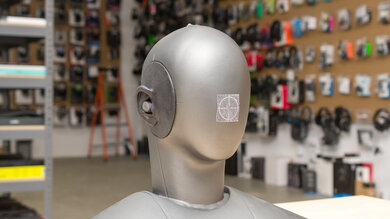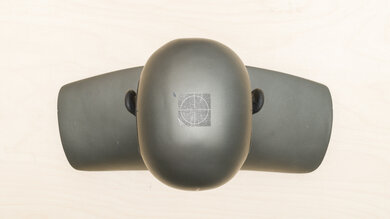The Jabra Elite 5 True Wireless are one of Jabra's premium in-ears for casual use. They have a hybrid active noise cancelling (ANC) system that performs better than other ANC headphones from Jabra's Elite line up like the Jabra Elite 4 Active True Wireless. Although they lack the Multisensor Voice feature found on the Jabra Elite 7 Pro True Wireless, which helps eliminate wind noise on a call by picking up your voice via bone conduction along your jaw, they still have a fair mic quality, making them a solid choice for calls. You can also pair the headphones to two devices simultaneously and charge the case wirelessly. However, some users have reported a hissing sound in one or both earbuds.
Our Verdict
The Jabra Elite 5 True Wireless are unremarkable for neutral sound. They have a clear and balanced sound profile, but there's a big roll-off in their low bass, which means that audio lacks thump and rumble. They also have a dip in the mid-mid, which nudges vocals and lead instruments to the back of the mix. Their passive soundstage isn't very immersive, but this is due to their in-ear design. Fortunately, the in-app 5-band EQ and presets help you fine-tune the sound to your liking.
- 5-band EQ with presets in companion app.
- Bad passive soundstage.
The Jabra Elite 5 True Wireless are good for commuting and travel. They're comfortable, portable, and have an eight-hour continuous battery life. They can passively block out some noise, and while they have an ANC system, they still have a hard time blocking out the low rumbles of bus and plane engines. They can still help cut down mid-range sounds like ambient chatter.
- Well-built and comfortable.
- Eight-hour continuous battery life.
- Mediocre ANC.
The Jabra Elite 5 True Wireless are great for sports and fitness. With a comfortable and deep in-ear fit, as well as an IP55 rating for protection against dust and direct water exposure, you won't risk them falling out or getting damaged during a run. However, they lack stability fins and may pop out during high-intensity exercise.
- Well-built and comfortable.
- Eight-hour continuous battery life.
- Mediocre ANC.
The Jabra Elite 5 True Wireless are decent for office use. They're comfortable and have an eight-hour continuous battery life, meaning they'll last the whole day on a single charge. They do a good job eliminating high-end frequencies like office chatter and hardly leak any audio. They also support multi-device pairing, meaning you can switch between your phone and laptop with ease.
- Well-built and comfortable.
- Supports multi-device pairing.
- Mediocre ANC.
- Mic has passable noise handling.
The Jabra Elite 5 True Wireless are Bluetooth-only headphones, meaning their latency is likely too high for wireless gaming.
The Jabra Elite 5 True Wireless are truly wireless headphones, and you can't use them wired.
The Jabra Elite 5 True Wireless are reasonable for phone calls. The integrated mic has a good recording quality, allowing your voice to sound clear and understandable but a little thin on the other end of the line. The mic does a passable job of isolating your voice from background noise in loud environments like a busy subway station. Even though these buds have ANC, they still have mediocre overall noise isolation, so hearing your call may be difficult in a busy train station or office.
- Well-built and comfortable.
- Mic has passable noise handling.
Check Price
Differences Between Sizes And Variants
The Jabra Elite 5 True Wireless come in two color variants: 'Titanium Black' and 'Gold Beige'. We tested the 'Titanium Black' variant, and you can see our model's label here. If you come across another variant, please let us know in the discussions, and we'll update our review.
Popular Headphones Comparisons
The Jabra Elite 5 True Wireless perform similarly to other Jabra in-ears, so you may want one or the other, depending on your preferences. Compared to other Jabra products like the Jabra Elite 7 Active True Wireless and the Jabra Elite 3 True Wireless, these buds have a warmer sound, which you may prefer if you like cozy vocals and instruments without heavy bass. The Jabra Elite 7 Active True Wireless also has better performing ANC for low-end frequencies, which can block out the rumble of bus and plane engines during travel.
If you're looking for more earbuds, check out our recommendations for the best Jabra earbuds, the best noise cancelling earbuds, and the best wireless Bluetooth earbuds.
The Anker Soundcore Liberty 3 Pro Truly Wireless have significantly better ANC than the Jabra Elite 5 True Wireless. The Anker block out more ambient bass noise and also deliver a more bass-heavy sound profile, which may be desired if you listen to hip-hop or EDM. They're also more comfortable than the Jabra and support LDAC for playing Hi-Res audio. However, they only last around five hours on a single charge, compared to the Jabra's eight-hour continuous battery life. The Anker also don't support multi-device pairing, while the Jabra can pair to up to two devices simultaneously.
The Jabra Elite 7 Pro True Wireless are better headphones than the Jabra Elite 5 True Wireless. The Elite 7 pro are more comfortable, have better noise isolation, and have a more neutral sound profile, making them versatile enough for most kinds of audio. However, the Jabra Elite 5 can better separate your voice from background noise during a call.
The Jabra Elite 7 Active True Wireless are better sounding and more comfortable than the Jabra Elite 5 True Wireless. These in-ears outperform the Elite 5 in noise isolation and sound profile neutrality, which some users may prefer. They also have an IP57 rating for dust and water resistance compared to the Elite 5's IP55, making the Elite 7 Active a better choice for sports and fitness. Neither model comes with stability fins, but both models stay in your ear during intense exercise. They also have the same eight-hour continuous battery life.
The Sony WF-1000XM4 Truly Wireless are better overall earbuds than the Jabra Elite 5 Truly Wireless. The Sony have a warm sound profile with more bass, which some users may prefer, and a longer continuous battery life of 10.5 hours. The ANC on the Sony cuts out more bus and plane engine noise, making them an ideal choice for commuters. However, the Jabra leak less audio at high volumes and their mic's recording quality is significantly better.
Test Results

The Jabra Elite 5 have a similar teardrop earbud shape as the Jabra Elite 3 True Wireless. There's a small manufacturer's logo printed on the back of the body, and they stick out of your ear a little. They come in two monochromatic color variants: 'Titanium Black' and 'Gold Beige'.
These earbuds are decently comfortable. They're lightweight and don't put much pressure on your ears. However, they create a plunger-like feeling, and using the physical control buttons can push the buds further into your ears, which can be uncomfortable over time.
The Jabra Elite 5 have great controls. Each bud has a physical button that's clicky and responsive. The controls aren't intuitive since each bud has its own control scheme. The buds feature HearThrough technology, which lets you hear ambient sound while wearing the headphones to engage in a conversation or hear someone. You can also enable the controls to toggle Spotify Tap, which either restarts your last listening session or selects a new playlist for you to listen to. There are no voice prompts, but the earbuds give you feedback tones to indicate input commands when powered on and off.
On the left earbud:
- Single press: Cycles between ANC/Off/HearThrough.
- Double press: Activates voice assistant and Spotify Tap.
- Press and hold: Lowers the volume during a call or when audio is playing.
On the right earbud:
- Single press: Plays or pauses audio.
- Double press: Skips to the next track.
- Triple press: Skips to previous track.
- Press and hold: Raises the volume during a call or when audio is playing.
On either earbud:
- Single press: Answers a call as well as mutes and unmutes the mic when you're in a call.
- Double-press: Ends and rejects calls.
These earbuds have a great carrying case. It's a similar design to the Jabra Elite 4 Active True Wireless' case. Magnets hold the buds in place, and a single LED indicates the case's battery status. This case also supports wireless charging.
These headphones have good build quality. They're mostly made of plastic with silicone ear tips. They feel sturdy enough to survive a few drops without damage and have an IP55 rating for protection against dust and direct water exposure. Unfortunately, like the Jabra Elite 4 Active True Wireless, the control buttons feel a bit cheap.
The Jabra Elite 5 have a clear and balanced sound profile. Although they have significant bass roll-off and lack thump and rumble, they still have a touch of bass to add boom and warmth to mixes. Lead instruments and vocals sound clear, and an emphasis in the mid-treble makes sibilants like cymbals bright but not overly piercing. If you're looking for more sound personalization, their companion app features a 5-band EQ with presets.
Note: some users have reported a hissing noise coming from one or both earbuds. Our unit didn't experience this issue but if you have had this problem, please mention it in the discussions.
These in-ear headphones have excellent frequency response consistency. If you can get an airtight seal, you'll get consistent bass and treble delivery each time you use them.
The Jabra Elite 4 have mediocre bass accuracy. The low-bass and mid-bass are both underemphasized, so audio lacks boom, thump, and rumble. The high-bass is still neutral, so the bassline in songs like Dreams by Fleetwood Mac still sound warm and full.
These earbuds have great mid accuracy. The mid range is somewhat flat, but there's a slight mismatch between the left and right drivers. The dip in the low-mid affects the right driver more, making vocals and instruments sound a bit thin and hollow. The continuation of the dip into the mid-mid affects the left driver more prominently, nudging these sounds to the back of your mix. These dips are somewhat minor, and vocals, as well as instruments, still sound detailed and clear.
These headphones have good treble accuracy. Instruments sound detailed and present in the mix, while a slight overemphasis in the mid-treble makes sibilants like S and T sound crisp without being piercing.
The peaks and dips performance is adequate. There's a mismatch between the left and right drivers, which affects the balance of your audio. A wide peak in the high-bass helps to make up for the low-bass roll-off, giving the mix a bit more body. However, the drivers are most mismatched in the upper mid-range, with a dip in the mid-mid and a peak in the high-mid that makes vocals and instrumentals sound pushed back and honky simultaneously. A significant peak in the mid-treble also means that sibilants, like cymbals, sound piercing.
These headphones have good imaging performance. Jabra's products tend to have well-matched L/R drivers, especially within the Elite lineup, which are all in-ears. It's important for the accurate placement of objects like instruments in the stereo image. Our unit's drivers are mostly well-matched too. However, there's a peak in the mid-range of the phase response, which indicates an audible mismatch. The left driver is louder than the right, and it can be heard with real-life content like music. Imaging can vary between units depending on quality control and ergonomics, though.
The passive soundstage on these earbuds is bad, which is typical for in-ear headphones. Sound needs to interact with the outer ear to create a wide and immersive soundstage. These aren't designed for that since they fit straight inside your ear canal. Audio sounds like it's coming from the inside of your head rather than from speakers placed in the room around you. They also don't feel as spacious as headphones with an open-back design.
These earbuds have a good weighted harmonic distortion performance. All frequencies fall within acceptable limits, resulting in clean and pure audio reproduction.
These are the settings used to test the Jabra Elite 5 True Wireless. Our results are only valid when used in this configuration.
These in-ear headphones have passable noise isolation. Unlike most other noise cancelling Jabra earbuds like the Jabra Elite 4 Active True Wireless, their ANC can block out slightly more ambient sound than when used passively. Although the ANC doesn't perform that much better, and it can still be hard to hear the difference between both forms of isolation, it can still block out mid-range noise like ambient chatter well. Unfortunately, the buds struggle to cut out the low rumble of bus and plane engines, making them a mediocre choice for commuting compared to other noise cancelling earbuds like the Sony WF-1000XM4 Truly Wireless.
Like a lot of in-ears, these earbuds have an amazing leakage performance. They don't leak much sound, meaning you can turn up the jams without disturbing people around you.
The integrated mic has good recording quality. Your voice lacks body but is clear and easily understandable.
The noise handling on the integrated mic is unremarkable. It performs similarly to the Jabra Elite 4 Active True Wireless and struggles to separate your voice from background noise. If you're taking a call on a busy street or subway station, your voice may be drowned out.
The Jabra Elite 5 have good battery performance. The manufacturer advertises them to have a seven-hour continuous battery life, but we measured them lasting longer at eight hours. The case comes with three additional full charges, and you can fast charge them in 10 minutes for one hour of playback time. Keep in mind that battery life can vary depending on use, though.
The Jabra Sound+ app is good. You can see a video of how it works here. It's compatible with iOS and Android devices and includes a 5-band EQ with presets for sound customization. You can also use sliders to further personalize the ANC and HearThrough functions. You can toggle the voice assistant, activate Spotify Touch and change the music and media controls for the buttons as well. You can also access the 'Pink Noise' feature, which is a kind of constant sound that's advertised to help you fall asleep.
These earbuds have great Bluetooth connectivity. You can pair them to two devices simultaneously, but they don't support NFC pairing. They support the basic SBC codec as well as aptX, which is a proprietary codec designed to improve latency and sound quality over Bluetooth. Unfortunately, they still have high latency using either codec on PCs, which can result in your audio and visuals falling out of sync. However, they have extremely low latency on iOS and Android, meaning that video and audio won't fall out of sync on mobile devices. Some apps and devices compensate for latency, so your experience may vary.
These headphones can only connect to PCs via Bluetooth and have full mic and audio capability.















